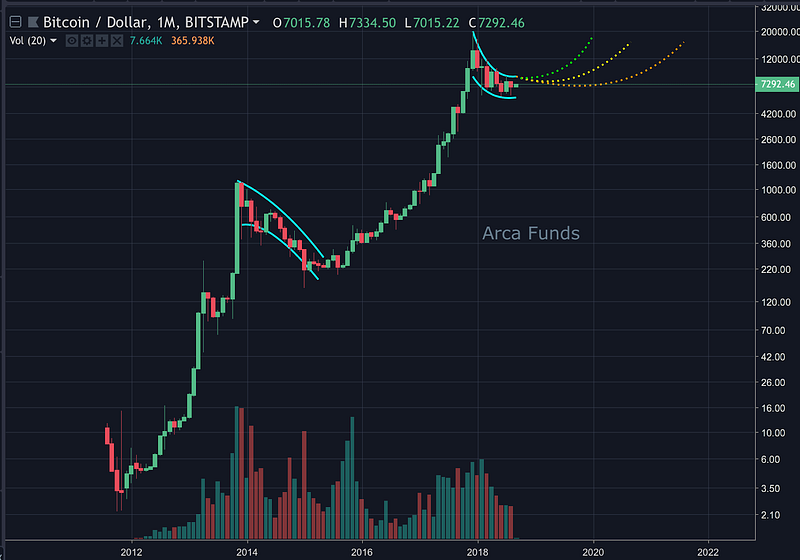What happened this week in the Crypto markets?
Window Dressing
Think of the end of the month as a narrative — the chart is a story and market forces determine the plot. Of course, asset managers report their returns monthly. And since, relative to other asset classes, a very small percentage of investors are actively formulating this narrative, it becomes fairly easy to push an agenda either way.
If we look back to last month, the price of Bitcoin experienced significant moves on July 31st ($8100) that lasted until August 11th ($6150). The end of this month was no different, as Bitcoin began its move on August 30th ($6850), and currently sits at $7250 as of Sunday. This is no coincidence — July was a great month for those long crypto, so they rushed to lock in gains at the end of the month, leading to a 2-week swoon. Conversely, August was a great month for those short the market, and they rushed to cover positions and lock in gains at month-end.
Seeing the Forest Through the Trees
But what is the narrative over a longer time horizon? That depends on who you ask. For those who entered the space in 2017, the narrative is that Bitcoin and the rest of crypto is just a speculative bubble, with which Bitcoin has lost ~70% of its value YTD. For those who entered the space much earlier, this is the ebb and flow that we all signed up for — volatile swings in both directions. If we look at the charts, we see that this ‘bear’ market is nothing more than a correction — albeit a long one. The bear market of 2014, following the Mt.Gox crash and subsequent fear in the market, had a different narrative than that of today.

It’s worth noting that Bitcoin has not posted a lower low in over 4 months. As such, it becomes increasingly clearer that the nature of this story does not correlate to the story told in 2014. While it is anyone’s guess as to when the market changes its narrative, it is imperative that we distinguish the differences between the two stories, making sure not to correlate what should not be correlated.
Ethereum and Futures Markets
The CBOE announced that they will offer Ethereum Futures later this year, and many are drawing similarities to the announcement of Bitcoin Futures, and the subsequent launch on December 18th 2017. When BTC Futures were announced, the price of Bitcoin ran up all the way to the all time high of $19,500 on December 17th 2017. It has been downhill ever since, with Futures markets pushing down the price ever since.
It can be hypothesized that large market influencers bought enormous quantities of Bitcoin leading up to the announcement, causing market hysteria and inflating the price irrationally. With no order book to support such volatile gains, these influencers then took their Bitcoin and shorted the market using Futures, thus capitalizing on the way up and the way down.
However, BTC Futures opened in a bull market, whereas ETH Futures are likely to open in a bear market. The price of Ethereum has moved down on extremely thin volume. When Futures launch, it would make more sense for big market players to go long Ethereum on thin order books — the exact inverse of Bitcoin.
This, paired with information that ETH will institute EIP-1234 and lower the block rewards from 3 ETH to 2 ETH in their Constantinople fork in October, offers a scenario where Ethereum may offer good upside returns in the near future. Similar to block halving for Bitcoin, which cuts block rewards in half every 4 years, this EIP will both reduce inflation of the asset and lower sellside pressure from miners.
Why are Mining Rewards Correlated with Higher Prices?
The answer lies within the heart of Proof of Work (PoW). Every day, miners have a decision to make — are the rewards received worth the cost of mining?
If the answer is no, most miners will turn off their rigs, waiting for profitable conditions to return. Since mining is an open market determined by the amount of miners and the amount of transactions, if transactions are kept the same but the amount of miners go down, each miner now mines more blocks — therefore earning more rewards.
So, with the profitability of mining ETH going from 3 ETH/block to 2 ETH/block, many miners might argue that a 33% reduction in rewards makes it unprofitable. For the retail miner, it’s a small problem. For large mining operations with a considerable amount of hashrate, this problem is intensified. Turning off millions of dollars worth of machines can be detrimental, as the upfront cost of said machines and the short lifespan of technology puts them in a bind.
These miners contribute pretty heavily to the sell side order book of Ethereum (same goes for any PoW-based asset) and could mutually agree to discontinue the selling of ETH until prices increase to a profitable level. Keeping the sell-side of the order books empty will push the price of Ethereum up — no sellers and consistent buyers.
It remains to be seen what will happen with Ethereum long term, but with the information available today, Ethereum will offer a litmus test for market economics regarding PoW-based assets not named Bitcoin.
I Believe that Children are our Future
The argument is no longer about Crypto’s staying power — and instead, becomes all about its power.
Notable Movers and Shakers
- Digibyte (DGB) is up 31.01% week-over-week, with a sudden increase in volume led by Singapore based Huobi (70% of overall daily volume). Digibyte also released v6.16.4 Blockchain core software this week, which could be a potential catalyst for the positive price action. It is interesting to note that a few weeks ago when the Turkish lira was experiencing hyperinflation, Turkish exchange Sistemkoin experienced a massive influx of people purchasing DGB with their lira. Digibyte is a cryptocurrency similar to Bitcoin, differing in block time (15 seconds), transactions per second (500), and algorithm variance (5).
- Icon (ICX) finished the week up 5%, after news came out on Tuesday that the foundation will be buying back $5 million worth of ICX from the market as a show of good faith in the project. ICX experienced a significant retracement from the all time highs in January (-93%), but looks to be finding a price floor.
What we’re reading this week
A good store of value becomes a vehicle with which to hide out during periods of uncertainty, depressing asset prices, or hyperinflation. A quick country-by-country look at Bitcoin demand shows that emerging markets are continuously using Bitcoin (BTC) as a way to get their money out of their respective countries. The fact that millions of people around the world are flocking to Bitcoin validates its existence.
You’ve heard us talk about the future of crypto assets, which includes the tokenization of just about any asset, including equity and debt. Platforms like OpenFinance are emerging to facilitate the compliant trading of these vehicles.
Let’s just say these processes will improve, but for now, this is a great read to understand the difficulties and precautions necessary to securely safeguard digital assets.
Self-regulation and the creation of best practices is a positive for the industry, and we applaud the Winklevoss group.
Hats off to our friends over at Ark Invest for this great analysis on Bitcoin transaction volume and corresponding value. Despite what you may have heard about Bitcoin not being used enough for actual transactions, it is now far more utilized than just about any other frequently used value transfer mechanism other than Visa and top credit cards.
Arca in the News
When a company creates an exit for a high margin cash flowing business, it usually indicates diminishing growth or margins. This could also indicate a continued bear market for Bitcoin.
And That’s Our Two Satoshis!
Thanks for reading everyone! Questions or comments, just let us know.
The Arca Portfolio Management Team
Jeff Dorman, CFA — Portfolio Manager
Katie Talati — Director of Research
Hassan Bassiri , CFA — Junior PM / Analyst
To learn more or talk to us about investing in digital assets and cryptocurrency
.jpg)



